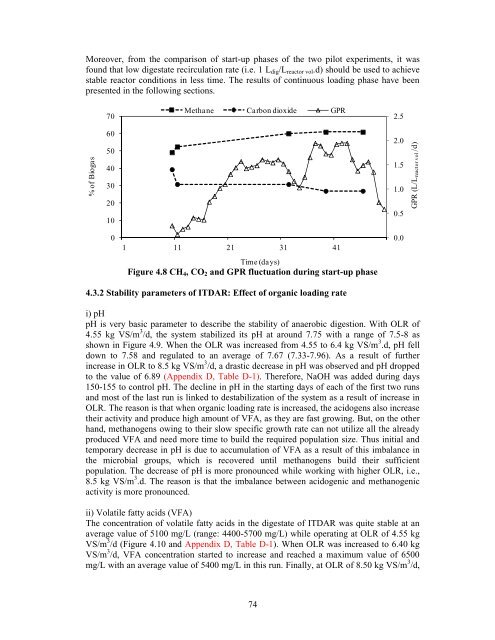dry anaerobic digestion of municipal solid waste and digestate ...
dry anaerobic digestion of municipal solid waste and digestate ...
dry anaerobic digestion of municipal solid waste and digestate ...
Create successful ePaper yourself
Turn your PDF publications into a flip-book with our unique Google optimized e-Paper software.
Moreover, from the comparison <strong>of</strong> start-up phases <strong>of</strong> the two pilot experiments, it was<br />
found that low <strong>digestate</strong> recirculation rate (i.e. 1 Ldig/Lreactor vol.d) should be used to achieve<br />
stable reactor conditions in less time. The results <strong>of</strong> continuous loading phase have been<br />
presented in the following sections.<br />
% <strong>of</strong> Biogas<br />
70<br />
60<br />
50<br />
40<br />
30<br />
20<br />
10<br />
0<br />
Methane Carbon dioxide GPR<br />
1 11 21 31 41<br />
Time (days)<br />
Figure 4.8 CH4, CO2 <strong>and</strong> GPR fluctuation during start-up phase<br />
4.3.2 Stability parameters <strong>of</strong> ITDAR: Effect <strong>of</strong> organic loading rate<br />
i) pH<br />
pH is very basic parameter to describe the stability <strong>of</strong> <strong>anaerobic</strong> <strong>digestion</strong>. With OLR <strong>of</strong><br />
4.55 kg VS/m 3 /d, the system stabilized its pH at around 7.75 with a range <strong>of</strong> 7.5-8 as<br />
shown in Figure 4.9. When the OLR was increased from 4.55 to 6.4 kg VS/m 3 .d, pH fell<br />
down to 7.58 <strong>and</strong> regulated to an average <strong>of</strong> 7.67 (7.33 -7.96). As a result <strong>of</strong> further<br />
increase in OLR to 8.5 kg VS/m 3 /d, a drastic decrease in pH was observed <strong>and</strong> pH dropped<br />
to the value <strong>of</strong> 6.89 (Appendix D, Table D-1). Therefore, NaOH was added during days<br />
150-155 to control pH. The decline in pH in the starting days <strong>of</strong> each <strong>of</strong> the first two runs<br />
<strong>and</strong> most <strong>of</strong> the last run is linked to destabilization <strong>of</strong> the system as a result <strong>of</strong> increase in<br />
OLR. The reason is that when organic loading rate is increased, the acidogens also increase<br />
their activity <strong>and</strong> produce high amount <strong>of</strong> VFA, as they are fast growing. But, on the other<br />
h<strong>and</strong>, methanogens owing to their slow specific growth rate can not utilize all the already<br />
produced VFA <strong>and</strong> need more time to build the required population size. Thus initial <strong>and</strong><br />
temporary decrease in pH is due to accumulation <strong>of</strong> VFA as a result <strong>of</strong> this imbalance in<br />
the microbial groups, which is recovered until methanogens build their sufficient<br />
population. The decrease <strong>of</strong> pH is more pronounced while working with higher OLR, i.e.,<br />
8.5 kg VS/m 3 .d. The reason is that the imbalance between acidogenic <strong>and</strong> methanogenic<br />
activity is more pronounced.<br />
ii) Volatile fatty acids (VFA)<br />
The concentration <strong>of</strong> volatile fatty acids in the <strong>digestate</strong> <strong>of</strong> ITDAR was quite stable at an<br />
average value <strong>of</strong> 5100 mg/L (range: 4400-5700 mg/L) while operating at OLR <strong>of</strong> 4.55 kg<br />
VS/m 3 /d (Figure 4.10 <strong>and</strong> Appendix D, Table D-1). When OLR was increased to 6.40 kg<br />
VS/m 3 /d, VFA concentration started to increase <strong>and</strong> reached a maximum value <strong>of</strong> 6500<br />
mg/L with an average value <strong>of</strong> 5400 mg/L in this run. Finally, at OLR <strong>of</strong> 8.50 kg VS/m 3 /d,<br />
74<br />
2.5<br />
2.0<br />
1.5<br />
1.0<br />
0.5<br />
0.0<br />
GPR (L/Lreactor vol./d)

















